What is Content Marketing: Your Ultimate Guide
Build trust and win online using effective content marketing
What is Content Marketing:
Your Ultimate Guide
Build trust and win online using effective content marketing

What is Content Marketing: Your Ultimate Guide
Are you wondering how to effectively capture the attention of your ideal customers?
Or maybe you’re searching for methods to place your brand at the forefront of your target audience’s minds.
These can be achieved through the strategic use of content marketing.
The way of conducting business has continued to evolve over the years. The introduction of the internet has revolutionized methods of business growth.
Technology has also provided novel ways to reach more people and market your brand. Businesses can now serve and be found by anyone from anywhere in the world.
However, the reach the internet provides isn’t much of a benefit except when utilized strategically. Your strategy has to entail how to stand out and connect with your target audience in the overcrowded digital space.
The point of marketing isn’t to simply reach more people. It’s to connect with more members of your target audience and lead them through your sales funnel.
In order to benefit from the range of influence the internet offers, your digital marketing strategies should be tailored to targeting, attracting, converting and retaining a specific audience. When done right, content marketing offers a sustainable way to achieve these goals.
With the continued evolution of the internet, content has become one of the most important techniques for you to market your company online. Below, we’ve provided a comprehensive guide on all you need to know about content marketing and how to wield it for your brand’s benefit.
Table of Content
- Why content marketing matters
- Types of content marketing
- Developing a content marketing strategy
- Developing a buyer’s persona
- Using competitive analysis to improve your content marketing
- Content creation strategy
- Content distribution
- What is a content management system?
- Audience Growth Strategies
- Why content marketing should be central to your digital marketing efforts
- Creating a digital marketing budget – how much should you spend?
- Why work with Stratwell?
Content is King as the saying goes. But before delving into its benefits, what exactly is content marketing?
Content Marketing is a strategic and deliberate process of creating and sharing relevant, informative, and consistent content to a defined target audience for the purpose of engaging and retaining customers.
There are many variations on the definition of content marketing available online. Whatever way you define it, the main takeaway is:
It works!
Here’s why:
Excellent content is legitimately engaging. Your audience doesn’t need to be convinced to read your content; it is convincing in itself. People seek it out for themselves and continue to consume it as it brings value to them.
Interestingly, they may not even grasp that what they love is actually a form of marketing. Even if they do realize, they’ll appreciate your goodwill to educating and helping them make informed decisions.
To ensure your content evokes this type of response and helps you achieve your business goals, it needs to be:
Valuable – the value your content produces must be worth the time it takes for your audience to consume it. Your content should educate, entertain or inspire your audience.
Relevant – Your content should address consumer’s needs, wants and interests. Gradually become the go-to resource they can turn to for solutions.
Let your audience be aware that you’ve got their back; that you understand what they are looking for and are willing to deliver your useful content in the forms they prefer.
Targeted – You aren’t out to serve everyone, and your content marketing efforts should reflect this. Ensure your content is designed for a specific audience, and you would increase its chances of bringing in the results you want.
Drive action – A good content strategy must drive profitable customer action.
The first question on most people’s mind once they have understood the concept of content marketing is “does it really work?”
Business owners and operators may frame their question as “does content marketing translate to measurable business results?”
The answer to both questions is yes.
And there are facts and figures to prove that content marketing facilitates the actualization of relevant business goals. Below are some statistics on why content marketing is effective:
- According to Content Marketing Institute, 72% of marketers report that content marketing increases engagement. From the same study, 72% of marketers also say it increases leads.
- According to Hubspot, businesses that blog get 55% more website visitors than businesses that don’t.
- A case study of Tiger Fitness showed that video content marketing led to a 60% returning customer rate.
- Content marketing costs 62% less than outbound marketing but generates three times as many leads, and 60% of people are inspired to seek out a product after reading about it. (Demand Metric).
- According to Aberdeen Group, businesses that create valuable content experience 7.8 times more site traffic than those that do not.
- Businesses that adopt content marketing experience a website conversion rate that’s almost six times higher than that of non-adopters (Aberdeen Group)
- IBM’s Digital Experience Survey revealed that 56% of marketers believe that personalized content promotes brand recall which in turn increases engagement.
- 24% of marketers plan on increasing their investment in content marketing. (HubSpot)
- Websites that publish content have 434% more pages indexed by search engine crawlers than those that do not publish, according to Tech Client.
- Email content marketing offers $42 as ROI on every $1 spent, as reported by Litmus.
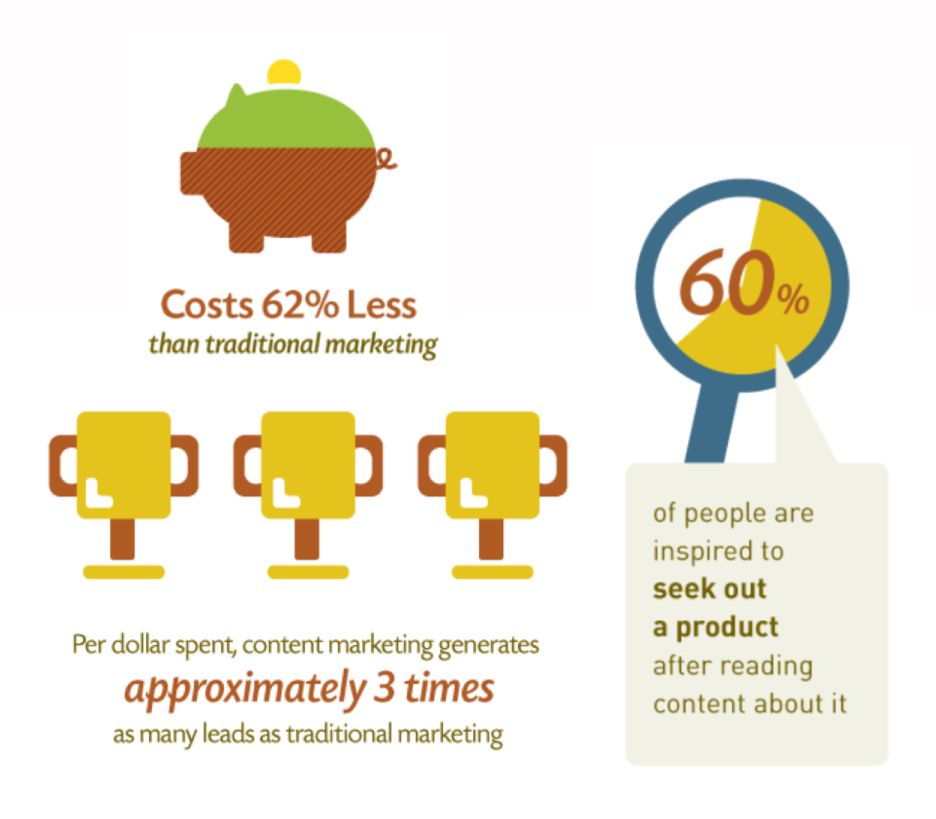
Why Content Marketing Matters to Your Business
Compelling content can help you build customer relationship without going through the hurdles of other hard-sell tactics. It frontlines your expertise on the subject matter and buys you trust by highlighting important issues that affect your prospects.
Well-designed content can draw massive traffic to your websites, blogs and social media accounts and boost performance on search results. Such results will help to build your brand’s online presence.
Many international brands such as John Deere and Michelin were able to build a solid following with their own well-crafted unique content marketing strategies.
When it comes to content marketing, there are various types that businesses can choose from. It’s important to understand which channels will align with your brand the best.
For example, Adidas likes to mix it up by making celebrity videos, social media posts on LinkedIn and Twitter and utilizing email marketing. Shutterstock prefers to use infographics, images, videos and even music.
It boils to what type of content marketing promotes your business effectively. And there are numerous content marketing types to choose from when creating your content marketing plan.
Here is a list of the essential types of content marketing that every marketer should consider:
- Blogs
- Videos
- Infographics
- Case Studies
- eBooks
- User-generated Content
- Checklists
- Memes
- Testimonials/Reviews
- Whitepapers
- How-to Guides/Academies
- Influencers/Paid Ad Content
- Social media
Whether you are new to content marketing or already using it, it doesn’t hurt to take a look at your content strategy plan. You should aim to make sure it’s updated and innovative, with relevant information that covers every question that your prospective customers may ask.
Competition is getting stiffer and it’s important for you to get ahead of the pack by actively engaging your audience. To do that, you need a rock-solid and well-defined content marketing plan at your disposal.
Here we’ll dive into what content strategy is, why your business needs a content marketing plan, and what steps you need to take to develop your strategy.
What is Content Strategy?
Content strategy refers to the management of all actual media content that you create and own: written, visual, downloadable — you name it. Content strategy is the piece of your marketing plan that consistently exhibits who you are and your expertise in your industry.
You may have already realized that having great content is a key component of any content marketing campaign. However, attempting to take advantage of content would be futile if there is no sound plan to push it through.
How to Create a Content Marketing Strategy
Now, let’s dive in to find out the specifics of the way to create a content marketing plan.
Define Your Goal
What’s your objective for providing content online? Know your goals before you start planning, and you will have a better time determining what’s best for your strategy.
Conduct Buyer Persona Research
To develop a successful plan, you would need to know who your audience is. As such, it is important to develop your buyer persona.
This is especially so for those new to marketing. By knowing your audience, you’ll produce more relevant and valuable content that will appeal to them, so that you can continue to move them through your marketing funnel.
If you have already developed a buyer persona, it is also beneficial to revisit it regularly to see if anything has changed.
Do you want to focus on a replacement group of individuals or expand your current target market? Do you want to stay an equivalent target audience?
Revisiting your audience parameters by conducting marketing research regularly is crucial to developing a sound content marketing plan.
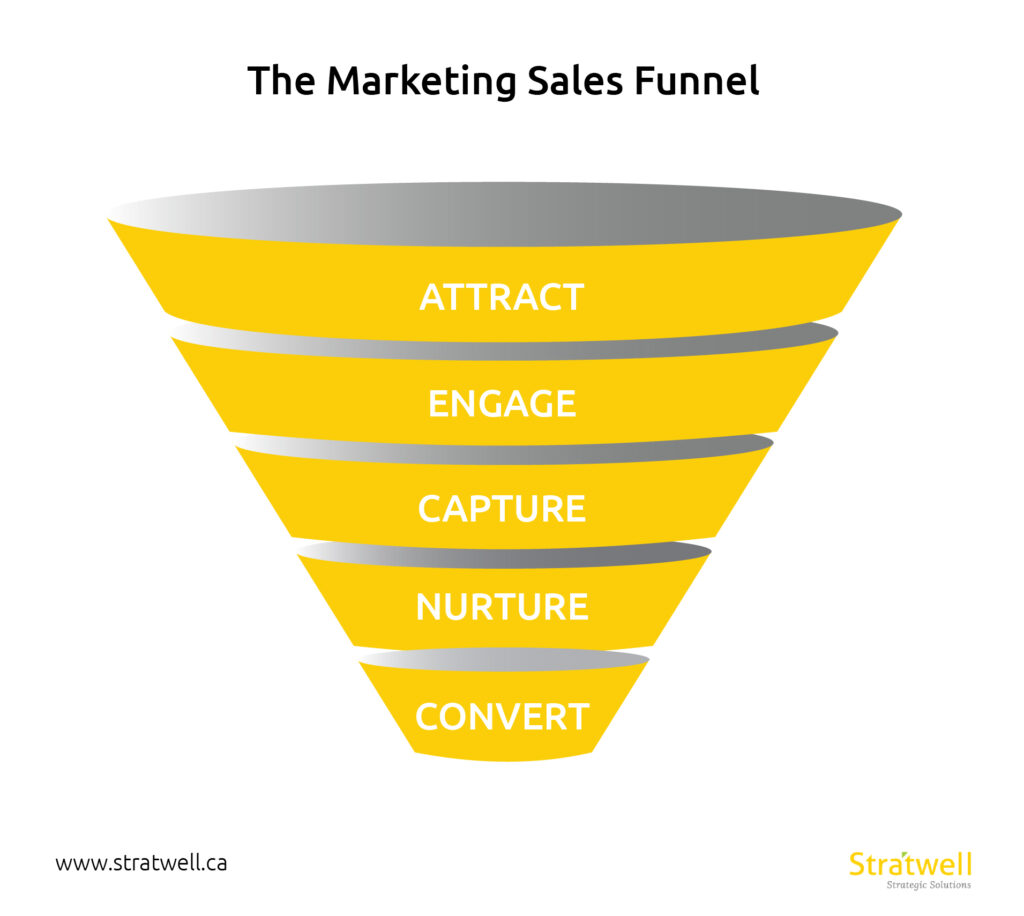
Choose a Content Management System
Have a system in place where you’ll create, manage, and track your content, otherwise referred to as a content management system (CMS). A couple of vital parts of content management include content creation, content publication, and content analytics.
Brainstorm Content Ideas
This is where you start coming up with ideas for your next content project; building intriguing and captivating options for your audience. There are a few tools to get the wheels turning including Blog about, Feedly, BuzzSumo etc.
Determine Which Sorts of Content You Want
There are options out there for the content that you’ll create. We have earlier discussed a number of the most popular content formats marketers are using to help you get started.
Publish and Manage Your Content
Your marketing plan should transcend the kinds of content you’ll create — it should also cover how you’ll organize your content.
With the assistance of an article calendar, you will be on the proper track for publishing a well-balanced and diverse content library on your website. Then, create a social media content calendar so you’ll promote and manage your content on other channels.
Depending on your industry and niche, most of your content is likely going to be evergreen — they will be as relevant years from now as they’re today.
Even though this may be the case, you should not ignore timely topics either. While they’ll not take up the majority of the spots on your editorial calendar, they will pique your audience’s interest and support the rest of the content you’ve created.
We have created a 13-step process on creating a comprehensive content marketing strategy. Click here if you are interested to learning more.
Developing a Buyer’s Persona
“The most obvious, ubiquitous, important realities are often the ones that are the hardest to see and talk about.” These are the words of the late David Foster Wallace, American author and English professor.
In more explicit terms, DFW meant that our lives’ most important details are the easiest to miss or ignore. They are right there in plain sight, but we hardly acknowledge them. This is true for every human endeavour, including business.
Businesses are created to serve customers. But how many times have we seen business owners build things people did not want or roll out marketing strategies that did not resonate with their audience?
A lot of times!
It’s because usually, they fail to pay enough attention to the crucial but easily forgotten fact that their products and strategies should be built around people’s needs and preferences. They can only do this when they genuinely understand those they have chosen to serve.
And that’s something that can be achieved through defining your target buyer’s persona.
A buyer’s persona is a detailed representation of your ideal customer. The keyword here being “detailed.” It’s not a hurriedly put together three-sentence description of your target audience.
It’s more or less like a dossier that includes deeply researched and sometimes very personal details of those you’ve built a solution for. You’ll be looking at uncovering your audience’s needs, goals, and buying habits.
Like many other aspects of your business, your content marketing efforts need to revolve around your target audience. With a buyer’s persona, you can create the right content, put it on the right platforms and get the desired results.
Let’s take a brief look at how to create buyer’s personas and apply them in the context of content marketing.
Research Your Audience
The first step in creating a buyer’s persona is to dig up as much relevant information about your audience as you can. You should know what to look for, as not every detail will help shape your content marketing efforts.
First, get the primary data out of the way. These will include your persona’s age range, occupation, job title and possibly, location.
Your next concern should be your audience’s goals and needs. Then look at the stories that might catch their attention based on their objectives and problems.
Your research should also extend to their content consumption habits. For instance, on what channels do they prefer to access information? What devices do they use in accessing those channels? How much information are they willing to take in at a time, and how often?
You’re probably wondering how you can possibly find answers to these questions. There are several methods, depending on whether you’re sourcing your information from prospects or customers.
You can arrange one-on-one interviews, send out surveys or better still, have conversations with your sales team to glean relevant insights. Most marketers forget to involve their sales team when creating their marketing plans. They often have valuable insights as they get instantaneous feedback when they speak to customers at the frontline.
Other information gathering methods include conducting A/B tests on existing content, using social listening tools, and analyzing current content consumption data (page views, downloads, bounce rates, etc.)
Develop Your Personas
Once you’re done gathering enough relevant information, examine what you have. Your initial goal here would be to make sense of the data you’ve collected.
The level of difficulty in analyzing this data varies depending on the data category you’re considering. A rule of thumb is to ask what a particular detail tells you about your audience’s content preferences.
Find out how specific insights can help you create compelling content that will achieve your goals. This activity will help you weed out information that may not be useful in improving your content marketing.
Your next step should then be to group similar relevant insights and label them as different audience segments. This is important because you’ll likely find multiple audience groups within your broader target audience.
It would be best to create custom content plans for each one. However, you do not have to cater to all the personas at once. That may stretch your resources too thin.
Instead, target your most favoured segment first. With that said, it never hurts to retain the information you’ve gathered on other audience subgroups for when you’re ready to target them.
It’s also worth noting that you will need to update the existing buyer’s personas with time. Your business will continue to evolve and customers’ preferences may change. As such, you will need to keep up with such new developments to ensure the content that you create remains relevant to your ideal targeted customers.
Apply Your Buyer’s Personas to Content Strategy Creation
One key aspect of your buyer’s persona is the buyer’s journey. This identifies the stages your typical customer goes through before making a purchase. The details you uncover here will be useful in creating the core of your content marketing strategy.
While the buyer’s journey shows the pathway that prospects take unto becoming customers, you can dig deeper to find out their activities, objectives and informational needs in every stage. This way, you can create content that will provide answers to your prospects’ questions at every phase of their buyer’s journey.
Such spot-on content pieces will be useful in guiding leads down your sales funnel.
Knowledge of your current customers’ needs will also come in handy in identifying the types of content you need to keep them engaged. You also want to see how you can nurture your relationship with them by providing value through content even after a sale.
Information from your buyer’s persona should also be used to determine your content formats, length, distribution strategies and channels. Your goal is to check all the boxes on your audience’s content preference list to maximize the effectiveness of your efforts.
To read more about how to create a buyer’s persona, please visit our blog post here.
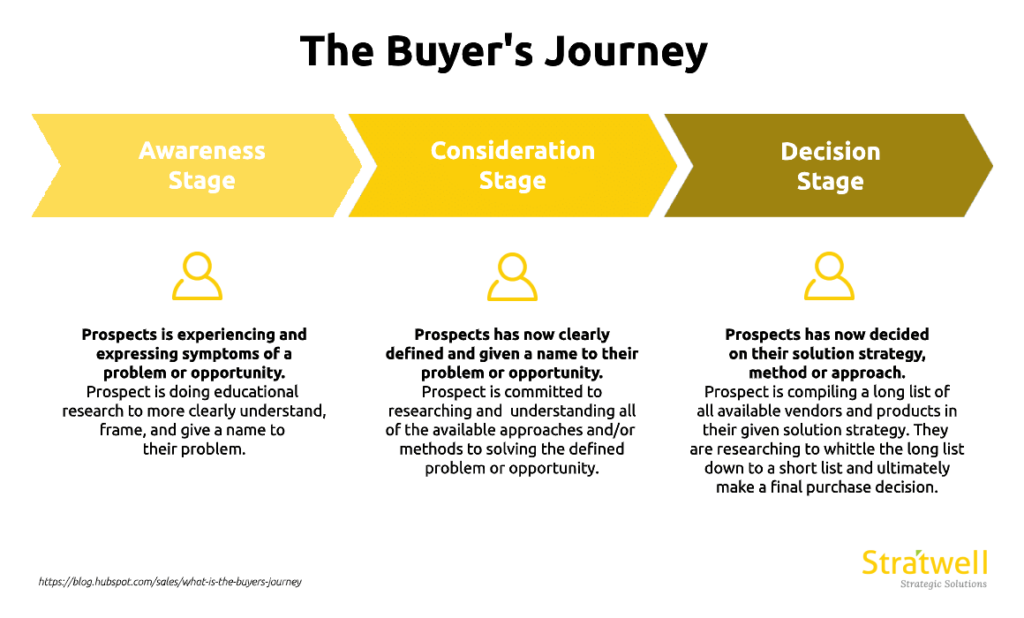
Taking a look at what your competition is doing is a great way to get industry insights on how you may run your business. You should note that the benefits of competitive analysis lie in what you do with the insights you get.
If you duplicate your competition’s strategies, then you’d be throwing your hat into an overcrowded mix, hoping to be picked by your target audience. A better approach would be to learn from the information you’ve gathered, get creative and look to do better.
This strategy also works well with your content marketing efforts.
Let’s find out how you can analyze your competitor’s content marketing strategy and use the insights to your benefit.
Identify Your Key Competitors
Identifying your competition may seem like a straightforward task, but it’s not as simple as you think. Many tend to tag every company in their industry as a competitor.
However, to stand out from the crowd and be successful with content marketing, a more nuanced approach to determining your competition is required.
Content marketing’s success depends mostly on factors like personalization and targeting. It’s about creating relevant stories for a particular community.
Not every brand in your industry is going after the same audience segment. Due to this, you want to ensure that you’re focused on analyzing the content marketing plans of businesses that are targeting the same audience as you are.
That’s how you’ll get actionable insights relevant to your situation.
To find out who your direct competitors are, you can examine your buyer’s personas and look for companies that are peddling marketing messages to them.
Record Competitors’ Content Types
Here’s where the heavy lifting begins. You’ll want to get a full picture of the content your key competitors have created.
This would require you to visit their publishing platforms and take inventory of their content. Your little research expedition will expose you to certain vital factors necessary to understand crucial details on the types of content your audience enjoys.
Begin by identifying the various content forms the competition favours. These could be blog posts, e-books, whitepapers, videos, podcasts, webinars, etc.
By paying attention to the level of investment your competition spends on certain content types and topics, you can find out which ones are worth your attention. You should also focus on the channels your competition uses and the frequency with which they publish content on those channels.
Once you figure out these essential details, you can start planning knowing you’re doing so on a reliable foundation.
Analyze Content Pieces
Consider the previously discussed steps as analyses done with prescribed glasses. But here’s where you scrutinize your competition’s content with an electron microscope.
You’re looking for the littlest, albeit crucial details that can help you differentiate yourself and place your business at the top of your audience’s minds.
Examine as many of your competition’s content pieces as you can.
What are you looking for?
First off, content quality levels. How detailed are their content pieces? How well do they address the informational needs of your audience? What’s the quality of the available information, and what level of engagement do these content pieces garner?
Answers to these questions can provide insights on some of the content gaps you can fill to your advantage.
Here’s the tasking part: you need to answer these questions for every topic cluster. To do this, you would have to first group the content pieces into varying topic clusters using a spreadsheet. Then evaluate each cluster’s quality as a whole.
That way, you can identify the gaps you need to fill to address the questions that your target audience may ask under each topic.
From each content piece, you can pinpoint crucial content details such as key targeted broad and sub-topics, keywords, content length, tone and language.
Content creation is unarguably one of the most essential components of content marketing. In this section, we’ll examine how to build a thorough plan for content creation and the steps involved in developing compelling content.
Building a Plan for Content Creation
Building a content creation plan relies heavily on your overall content marketing strategy and business objectives. This workflow enables you to breakdown the insights you’ve highlighted in your content marketing strategy into actionable items that will help you create content that works.
Highlight Broad Topics
Broad topics are typically extensive subjects that pique your audience’s interest. Audience and competition research are the activities that can bring such topics to light.
Your aim is to define the broad topics you’d like to cover with your content. In doing this, you can choose to narrow down your focus as you deem fit or as your industry or business type permits.
The key is to look for topics that are not too broad or too narrow, so that you can break them down into a series of sub-topics.
Develop Topic Clusters
Topic clusters are subtopics under broad concepts. You create them after identifying the key subjects you would like to cover.
To do this, you would need to conduct research to find out relevant branches of your broad topics. Your research will include digging up information about the main topics and discovering long-tail keywords you should be targeting.
The point of developing topic clusters is to break down the aspects of your broad subject into digestible chunks. It helps to engage your audience who may have different questions about that specific interest.
It’s also a strategy that enables you to create a web of inbound links within these pages for search optimization purposes. No matter how you look at it, the topic cluster strategy allows you to build strategic short, medium-length, and long-form content around an extensive subject that can improve the online visibility of your brand.
Content Mapping
A content map is a guide that helps you develop content for each stage of your audience’s buyer’s journey. It illustrates the information you need to guide people towards a buying decision.
You begin to create a content map by first examining your buyer’s personas. Next, you select the audience segments you’ll be targeting then identify the buyer’s journey of each one.
What activities do your prospects go through when they discover a problem right up to when they solve it? What information do they need to successfully perform each action and move to the next one? How can you speed up their journey from one stage to the next?
These are some of the questions that need answering as you try to find out topics relevant to each phase of your audience’s buyer’s journey.
As earlier mentioned, it is important to note that you need to answer these questions for every buyer persona you’re targeting. The reason is you’d be creating content to cater to the varying needs of each of your personas at different stages in their buyer’s journey.
Develop Pillar Pages
As their name suggests, pillar pages are comprehensive content pages that hold together all the content on your blog.
A pillar page contains content that examines a broad topic and its many parts. Hence, it houses several subtopics. The general topics and subtopics pillar pages address are concepts you’ve identified as relevant to your target audience.
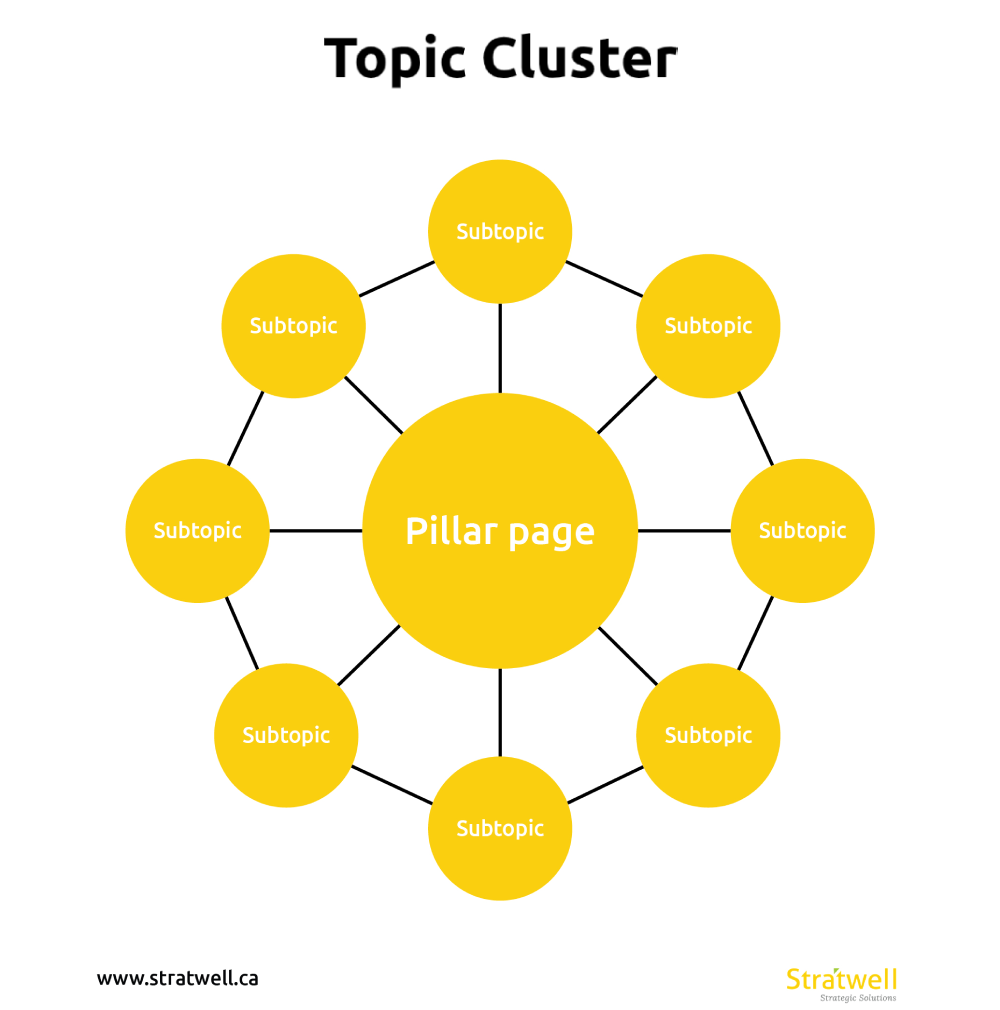
The essence of building pillar pages is to create a central focus for your content creation process and to offer in-depth information on selected topics on one web page. They also serve as link carriers that point to your subtopic pages.
This will aid your audience’s navigation of your site and improve your SEO growth. If you haven’t realized already, what you are currently reading is an example of a pillar page on the topic of content marketing.
Note that it is important to regularly review and update your pillar post to include any new stand-alone articles on that particular topic. That way, you will ensure that you are fully utilizing your resources.
Conduct Content Gap Analysis Often
A content gap analysis involves examining available content for deficiencies. It should be a mainstay of your content creation strategy for several reasons. For one, it shows you what needs to be done to create something better than what your competitor has.
There are two ways to conduct a content gap analysis. You can either scrutinize your portfolio or your competitor’s for loopholes.
It’s advisable to do both periodically since they expose you to different opportunities to improve the overall quality of your content.
As you go about your analysis, keep your audience’s goals and needs in mind. After all, the point of this analysis is to figure out how to create better materials for your audience.
The Content Creation Process – A Step By Step Guide
The content creation process is a system involving reliable steps you can follow to create quality content.
Keep in mind that the results for each content piece will vary. Some will be hits, some misses and others somewhere in between.
Such variation in results can stem from several factors, some of which may be totally out of your control. However, having more hits than duds is down to following a process that ensures you effectively harness factors within your control that make for excellent content.
Following a predefined process will allow you a better chance to consistently create content that wins.
SEO Research
SEO research is vital to validating the worth of content topics you identified when creating your buyer’s persona and coming up with your content marketing strategy. For instance, when you outlined these targeted subjects, you may have based them on the perceived goals and needs of your audience.
But that’s just your perception; it doesn’t always see the full picture. Some of these topics may, in fact, rank low on your audience’s hierarchy of needs and goals.
As such, creating content for these topics would mean that you may not get the results you are hoping for.
At other times, the problem could be that your audience is running searches using keywords different from the ones you are targeting.
However, by running simple keyword research, you can find out the volume of people searching for your outlined terms. This way, you’ll identify the keywords that are worth your efforts.
Also, keyword research will enable you to strategically choose topics to rank for. Some keywords are highly competitive. You have tons of websites writing about them, including those with high domain authority.
Choosing such keywords, especially if you’re just starting out, might be unproductive. Your content will likely be buried beneath the pile of similar works published on high authority websites.
But by looking for less competitive keywords, preferably those with lower search volume, you have a better chance of ranking for them and building your domain authority from there.
SEO tools like Ahrefs and SEMrush will give you in-depth keyword analysis, such as monthly search volume.
Ideation
In the ideation stage, you brainstorm ideas on how to develop your content based on the chosen keywords. Although this process can seem daunting, it can be significantly simplified by content marketing and content creation strategies.
This is because both plans contain vital factors that will influence the stories you choose to tell and, to no small extent, how you tell them. Such factors include knowledge about your target audience and its content preferences, a description of your brand voice, etc.
Once you get the recurring factors out of the way, you can focus on locking down your content’s creative angle. This would include your plan on how to present a specific content piece.
The idea here is to determine the most effective means to communicate your message and achieve your set objectives.
You’ll be concerned with surgical details like the look of your article’s intro, the storytelling techniques you’ll apply, the structure and flow of your outline, etc. You’re looking to tie all these details together to create a predefined experience for your audience when it interacts with your content.
Creation and Editing
Here’s the part many are eager to delve into, but few actually get right.
The creation stage isn’t where you throw out all relevant data and focus squarely on writing about your topic. On the contrary, it’s the point you apply insights from all your research to create something deserving your audience’s attention.
The first step is keeping in mind an image of who you’re writing to. Have your target buyer’s persona in mind. Give this fictional character a name if you want, then write with the aim to genuinely help this person.
This will ensure you pay more attention to every part of the content and its contribution to your goal to provide value to your audience.
As you write, stick to your brand voice. Don’t forget that you aren’t just trying to pique your audience’s interest.
You’re also attempting to build brand recognition, and that requires consistency in tonality. You don’t want to sound unlike yourself.
As such, stick to the language that you feel would represent your brand well.
It is also important to account for little details such as clarity, simplicity, and conciseness because they matter. Pay attention to these factors when you are drafting and editing your message.
Also watch out for your grammar, sentence length, punctuations, etc. Don’t fret; you can always enlist the help of editing tools like Grammarly and Hemingway Editor.
Publishing
Now you are ready to let your audience see what you’ve made. All you need to do at this stage is to give your work another once-over, tie up any loose ends, and click “publish.”
It is recommended that you stick to a publishing schedule by outlining days and times you’ll post new content. It’s one way of building a community of loyal content followers and introducing structure to your content creation efforts.
With a Content Management System, adhering to a structured publishing timetable is even easier since you can schedule posts and have them drop on the right platform at the desired time.
Content distribution is a critical piece of content marketing that centres around promoting your content to your intended audience through different media channels. It principally incorporates three distribution networks:
- Owned Channels: This comprises of any web property that you own, for example, your site, blog, portable application, pamphlet, online media accounts, etc.
- Earned Channels: Getting your content enhanced through outsider sources, for example, PR coverages, guest posts, organic sharing, etc.
- Paid Channels: This is any channel that requires you to pay to enhance the reach of your content. Paid content distribution incorporates every single paid advertisement, online media promotions, influencer showcasing, remarketing, etc.
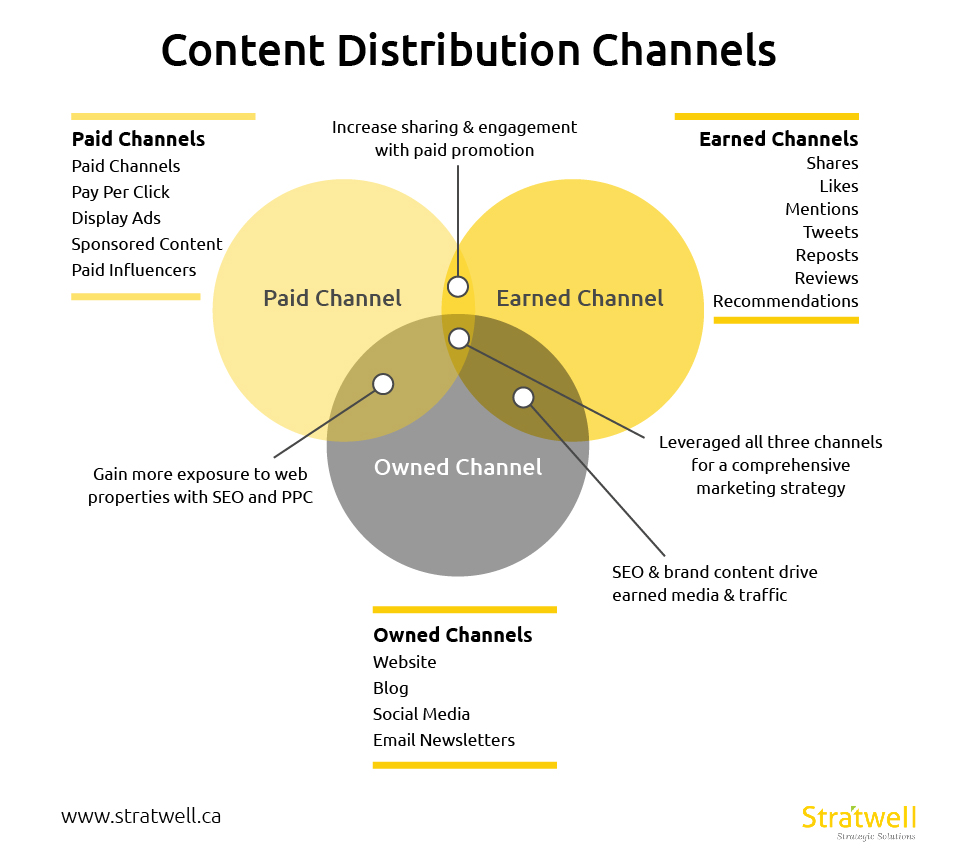
Let’s take a look at each of these content distribution techniques in detail.
Content Distribution Through Owned Channels
Brands have full control over owned channels. Owned media channels are the doorway to circulating your content across procured and paid distribution media.
While owned media gives you power over the content, the most significant test is to guide your target audience to your owned media channels.
Examples of owned media that an organization could use to its benefits include: website, blog and email marketing.
Content Distribution Through Earned Channels
The genuine test of how great your content is in the number of organic, third-party shares your content gets across different earned media channels.
Earned content distribution is especially tricky as your content will be highlighted on different publications, only if it is excellent and meets their guidelines. The way to getting others to discuss about you is to begin developing associations with influential individuals and publications within your industry.
Over the long run, you can share each other’s content and draw in a vaster audience.
Here are a few examples of earned content distribution:
Guest Posts
When you connect with idea pioneers, distribution channels and similar brands in your industry, there is the possibility that your content will be featured on their sites. Contingent upon the rules, you can likewise start up your SEO exercises by including backlinks to your local content.
Please click here if you would like to learn more about link building strategies.
Organic Sharing
Organic sharing is the magic that happens when you create content that resonates with your target audience.
People are enticed and feel the need to share what you’ve created with their own audience. And the best part is they are more willing to click the “share” or “retweet” buttons since they enjoyed the content.
That said, it’s advisable that when you make content of any sort, find a way to encourage your readers to share it with their circle. You can never go wrong with a gentle call to action.
PR Coverage
Being highlighted by top distribution channels inside your industry is the genuine apex of earned media. PR coverage is generally an opportunity to get talked about.
However, this applies if you accomplish something extraordinary that is worth mentioning, such as, winning an award, releasing a new product, etc.
Content Distribution Through Paid Channels
Consider this for a moment — have you ever thought of how you can better guide your traffic and optimize every last bit of your site?
You can circulate your content to your audience utilizing paid channels, for example, influencer marketing, search engine marketing, social media publicizing, etc. You can control the process by consistently adjusting your ads to enhance their effectiveness and get optimal outcomes within your budget.
Having an understanding on the various types of paid content distribution channels will allow you to utilize them effectively. Here are examples of some of the commonly used ones:
Influencer Marketing
Influencer advertising is tied in with enlisting the services of influential individuals with enormous followings, to promote your content via their media platforms.
Search Engine Marketing (SEM)
You can feature your content through paid advertisements when people are searching for a similar topic on search engines. SEM is a keyword-driven advertisement format where you optimize your marketing budget and ads for the keywords your target audience use in their searches.
Search engine marketing works in two different ways:
- Cost per Click (CPC): You pay when somebody clicks on your ad
- Cost per Mille (CPM): You pay for every thousand impressions on your advertisement
Social Media Ads
Social media platforms, for example, LinkedIn, Facebook, Instagram, Twitter, and Pinterest, permit you to market to your target audience by placing ads.
The effectiveness of social media promotions lies in the accuracy of the variables used in targeting your audience and the quality of your ad in terms of its design, text and format. You can target clients depending on their area, interests, age, content utilization designs and a few other segment qualities.
Remarketing
In general, remarketing or retargeting is a compelling advertising strategy that reconnects your business with users who have once visited your site. This strategy can help keep your business top-of-mind.
Click here if you would like to read more about content distribution channels.
Local Marketing
Local marketing involves the creation of marketing materials, campaigns and events designed for an audience in a specific location. The point is to use these marketing channels to transmit messages that speak directly to people within a locality and thus resonate with them deeply.
These messages will have strategic elements that your target audience in that location understands and values.
Think of Coca-Cola’s “Share a Coke” campaign that involved the distribution of cans and bottles of coke with common names of people to regions where those names are prevalent. They also made those cans and bottles available in the language with buzz words specific to those regions.
You also have Nike’s “Nothing Beats a Londoner” ads that showed what it was like to be a young sportsperson in London.
Both campaigns are prefect examples of local marketing. They were strategically tailored to appeal to the peculiar traits and interests of the brands’ audience in specific locations.
To pull off local marketing successfully, you would need to uncover key insights about your local market.
How is your product or service perceived in that location and how can you alter or reinforce that perception? What audience values can you leverage to get people talking about your business? What relevant social issues can your brand build conversations around?
You can use your answers to brainstorm content campaigns you can promote using paid targeted ads available on search engines and social media.
Another local marketing tool is Google My Business (GMB) page. It’s a Google listing that displays businesses, their address, contact information and work hours as results to relevant Google searches.
This tool is vital for local marketing because when prospects search for products or services, local businesses feature prominently in the results. This means people within your locality can find your business easily.
The additional upsides to this tool are that it’s free and simple to set up. All you have to do is claim or create your GMB page, wait for it to get verified and optimize it.
Managing content can be quite complicated especially if you are targeting multiple personas across several channels. It can get even more complex if you are collaborating with other contributors or creators.
A content management system (CMS) removes such potential snags.
A content management system is a tool used to manage and utilize website content. With this tool, users can create, edit and delete content from their site.
Typical CMS software offers an interface that does not require HTML skills or other technical programming knowledge.
Therefore, content creators and authors can make changes on sites without the help of a developer. Although, customizing the layout and experience might still require some coding experience.
What makes a useful content management software tool?
- A powerful and flexible editor
- The ability to allow team collaboration
- The ability to test and preview the result
- Accessibility to support
- Ability to integrate with the rest of your utility
Before we look into audience growth strategies, let’s start with the meaning of the word “Audience.”
So, what is an Audience?
Your audience isn’t the number of people who read, view or consume a particular content. Rather, it’s the number of people who have seen your creations and are going to revisit or consume your next one.
For instance, your video went viral on Youtube but none of the viewers subscribed to your channel. Were you able to grow an audience?
No! All you did was to give out free content without creating a fan base.
Audience growth strategies are methods, plans and frameworks put together to increase the number of people that consumes your content and can be influenced by you. They help you reach and connect with your customers on a personal level.
Here are some strategies you can consider for growing your audience:
Growing your audience through SEO
An SEO strategy is essential to help create organic and eligible leads to your website. With a better understanding of your target market, and effecting a tactical, data-driven SEO plan, you can effectively increase website traffic and prospective customers.
With the following steps, you can set up an SEO content marketing strategy:
- Determine your topic area
- Define your buyer’s personas and search intent
- Conduct a keyword research
- Create your content
- Update your content
- Promote your content
- Measure results
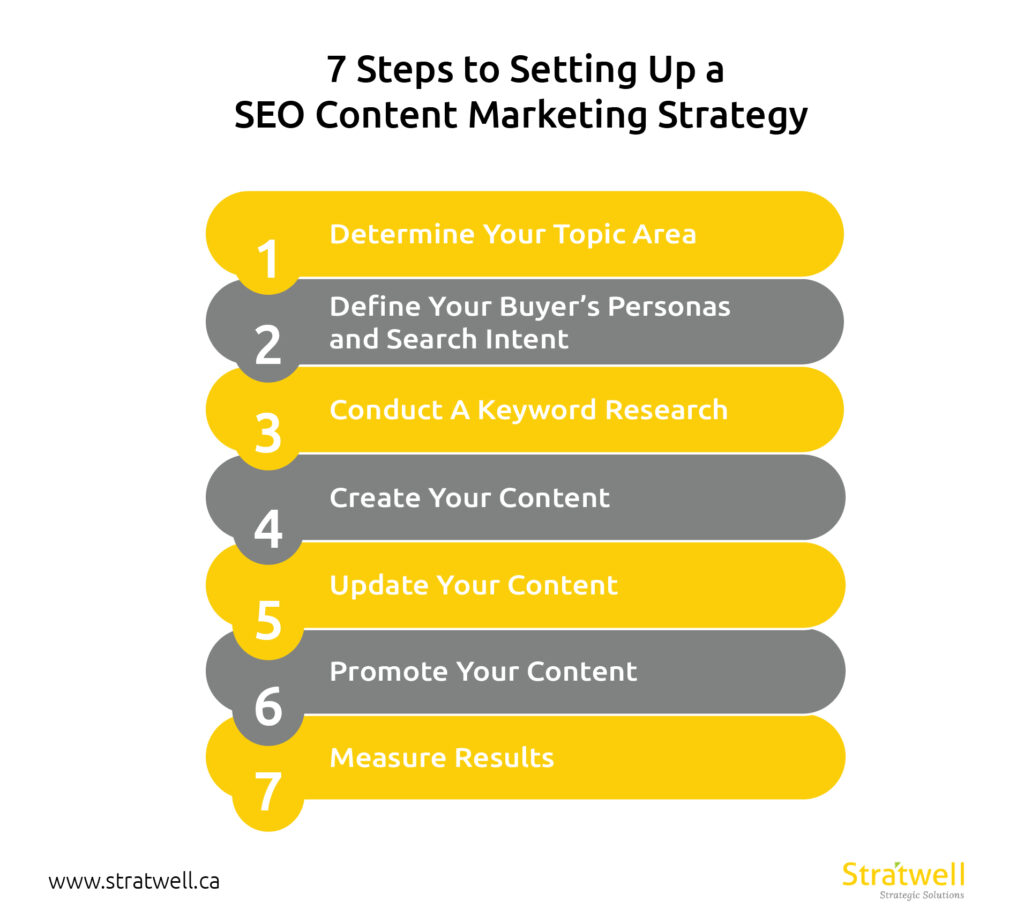
Growing your audience through lead magnets
With lead magnets, you are exchanging substances of value for a prospective customer’s contact information – email address – along the sales funnel. There are various forms of lead magnets to choose from depending on who your target audience is and where in the buyer’s journey its members are.
So be sure to take your time and find one that will work. Ultimately, a lead magnet has one goal, which is to maximize the number of targeted leads you would be getting for an offer.
Types of Lead magnets
- Guides or reports
- Toolkits
- Videos and webinars
- Product free trials
- Discounts
- Cheatsheets
Steps to setting up an effective lead magnet
- Define your target audience and a detailed buyer persona
- Choose the right form of lead magnet
- Link your lead magnet to a compelling substance of value to your target audience
- Study to measure results
For maximum results, lead magnet ideas must have the following key features:
- Highly Specific
- Give A Promise
- Speak to A Known Desire or Problem
- Immediate Gratification
- Shifts the Relationship
- High Perceived Value
- High Actual Value
Growing your audience through paid advertisement (Paid ads)
Paid advertisement, as discussed earlier, refers to a form of content promotion where you pay the owner of an ad platform to promote your brand. Paid advertisement is an objective-based and straightforward means of getting a broader reach to the public.
Forms of online paid advertising include:
- Pay Per Click advertising (PPC advertising): Google, social platforms etc.
- Social Media advertising (sponsored post/pages): Facebook, LinkedIn, Instagram etc.
- Native advertising: promotion listings, paid search ads etc.
To achieve great results with paid ads:
- Define the objectives of ads
- Clearly define the target audience
- Choose the right content to promote
- Ensure your ads link to your content
- Monitor results and improve
Why Content Marketing Should Be Central To Your Digital Marketing Efforts
By now, you should have realized how powerful content marketing can be if utilized effectively. Content is what drives meaningful online marketing and should be a mainstay of every vibrant digital marketing plan.
Essentially, content marketing should be viewed as the engine that propels your other digital strategies and assets.
Let’s start with the most basic of the lot: your website.
Your website is to your business what a brick-and-mortar store is to a franchise. However, instead of physical help desks, shelves, showrooms and store attendants, content runs the show.
From explaining your offerings to telling a compelling brand story, you need quality content to ensure your website contributes to your business’ growth. Therefore, having quality content should be your number one priority when constructing your website.
Search engine optimization also finds its roots deeply embedded in content marketing.
Content carries the keywords your website will rank for, but that’s not all. Search engine crawlers now prioritize content quality as a primary prerequisite for displaying a website on search engine results pages.
This implies that your SEO strategy’s success largely depends on the value and relevance of the information that is displayed on your website.
For social media, meaningful conversations, useful and amusing content are the spine of every brand’s social media marketing approach. And even if you lean more towards Pay-Per-Click ads, you’ll still need them to be attractive and clickable, along with landing pages brimming with persuasive information to win customers.
To further grasp the importance of content marketing, consider the role content plays in your digital sales funnel. Think of how you need to strategically offer information to various sections of your audience to move them through their buyer’s journey.
Right from making your prospects aware of their problem to positioning your product or service as the perfect solution, content is the most important key element that drives your message across. The better it is, the higher your chances of attracting quality leads and closing more deals.
Please click here if you would like to learn more about this topic.
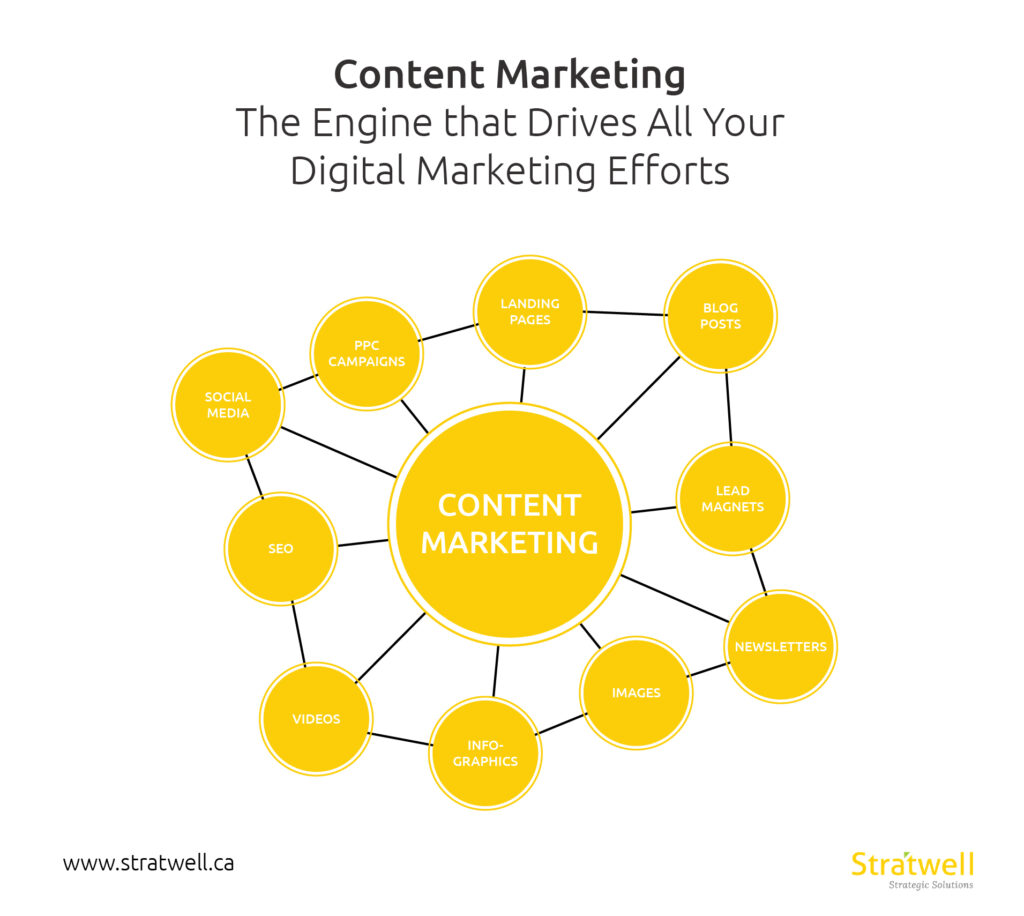
Before going into the specifics, new companies are generally advised to allocate between 12-20% of their revenue to marketing while established companies are told to dedicate around 6-12%. However, these figures can vary based on the company’s industry, niche and goals.
Also, on average businesses choose to allocate approximately 45-50% of their marketing funds to digital marketing. In order to determine how to allocate your funds effectively, you will have to decide on which digital channels to invest in and how much should go into each one.
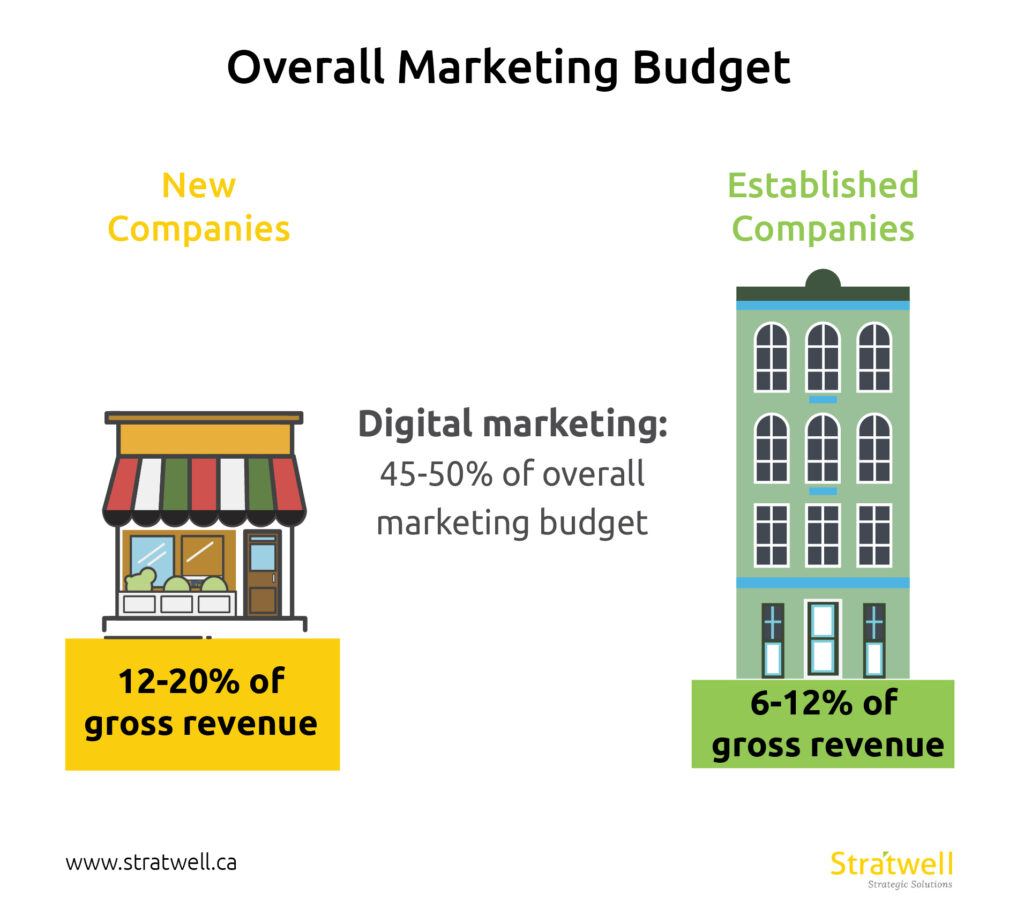
How to Create a Digital Marketing Budget that Works for You
When creating your digital marketing budget, it’s important to look at your unique situation and plan accordingly. You can’t simply adopt another company’s plan even if you want similar results.
This is perhaps the most critical point to note. Aim for personalization.
Here are a few steps that will help you arrive at a digital marketing budget that gets you results.
Know Your Target Audience
The point of marketing is to understand your target audience’s needs and provide the proper information to nurture them into or retain them as customers. Marketing strategies and campaigns are built for people.
As such, the traits and nuances of your target audience will determine how and where you’ll reach them. Therefore, it is important to have them in mind when creating a marketing budget.
Your previous results are a great source of information on your target audience. From such records, you can identify your audience’s preferred channels and consider them when planning for your new budget.
But don’t stop here. Look to your competitors and monitor current industry trends to discover the most effective platforms based on their popularity among your audience.
Use these valuable insights and assess them alongside your goals. Such preliminary knowledge on your target audience is to set you on the right track but you can discover new ideas and strategies when results start rolling in.
That’s why you should pay attention to your data so you can pivot when necessary.
Conduct More Research
Your research doesn’t end with your target audience. It’s also important to study industry trends and your competitors.
Some of your competitors are doing a great job in marketing and others not so much.
Learn from both sides. But don’t dive in without a plan; else, you’ll get lost amid the flurry of activities.
Look for specific areas to focus on. For example, what are your competitors doing on social media? How does your landing page compare to that of a better performing competitor? Are your competitors placing intense focus on a particular digital channel? It could be that they have found out something you haven’t, so pay attention.
You can also assess your previous results to find your best-performing platforms and tactics. By understanding how each channel has profited you in the past, you can extract insights that will help you to decide which platforms to focus on when creating your digital marketing budget.
Decide on Your Objectives
Before deciding how your digital marketing budget should look like, it’s important to determine what your objectives are. Otherwise, you’d end up wasting your scarce resources with such an approach.
Your first task then should be figuring out what you want for your business. Ask yourself what results you’d like to create. As you define and refine your goals, clarity sets in regarding the digital channels that are most suited to achieving them.
A little research on such digital channels will also give you an idea of how much it would cost to get the results you want using those platforms.
Determine the Channels to Invest in
The steps mentioned previously allow you to extract insights to make informed decisions concerning the channels to include on your marketing budget.
Your options include branding and rebranding efforts, content marketing, web design and optimization, search engine optimization, social media marketing, email marketing, Pay-per-click campaigns, etc.
The key, however, is to leverage great content so that you can optimize the results from all these platforms.
Evaluate Your Results and Adjust Your Strategy When Necessary
Results are vital signs that can help you make better marketing decisions, such as which channels you should be giving more attention and allocating more funds to.
But rather than strictly following what’s on paper, study carefully and measure your campaigns’ success based on clearly defined goals.
At the same time, don’t be afraid to take calculated risks like experimenting with a new strategy or totally cutting funding to another.
For more information about planning your marketing budget, please check out our blog post here.
We are grateful that you chose to read this to the end. We hope our guide has offered practical strategies and insights you can use to get the best out of content marketing. Feel free to share your thoughts in the comments section below on the aspects that resonated with you!
If you are trying to figure out how to implement a content marketing strategy within your organization, perhaps you can consider enlisting our team to help you with that.
Maybe you are already investing in digital marketing but want to see better results. Perhaps you are looking for a cost-effective way to attract prospects, win their trust and turn your business to the go-to option for your target audience.
Stratwell Strategic Solutions has a professional team in place to help you achieve all this and more.
Stratwell Strategic Solutions is a leading global content marketing agency that helps and teaches brands how to attract and retain customers through compelling, multichannel storytelling. Our mission is to help you grow your online presence through the practice of content marketing.
We do this by providing the expertise you need to grow your business by telling the stories that your audience crave.
Over the years, our team of professionals has used its expertise to grow businesses and organizations to impressive heights.
Our mode of operation includes the creation and implementation of custom strategies. We also continue to monitor and refine our methods and processes to take your business to where you want it to be.
Our services include:
- Content Marketing
- Content Strategy Development
- Web Development
- Content Development
- Social Media Management
- Pay Per Click Management
- Search Engine Optimization
Schedule a consultation with us today to see how we can help you achieve your business goals.
Was this article helpful? What are your thoughts on content marketing? Share your thoughts with us in the comment section below.
Enjoy this article? Subscribe to get similar articles delivered to your inbox and don’t forget to share it with your friends.
1. Why Content Marketing Matters?
2. Types of Content Marketing
3. Developing a Content Marketing Strategy
4. Developing a Buyer’s Persona
5. Using Competitive Analysis to Improve your Content Marketing
6. Content Creation Strategy
7. Content Distribution
8. What is a Content Management System?
10. Why Content Marketing Should be Central to your Digital Marketing Efforts?
11. Creating a Digital Marketing Budget – How Much Should You Spend?
12. Why Work with Stratwell?
Table of Content
1. Why content marketing matters
2. Types of content marketing
3. Developing a content marketing strategy
4. Developing a buyer’s persona
5. Using competitive analysis to improve your content marketing
6. Content creation strategy
7. Content distribution
8. What is a content management system?
9. Audience Growth Strategies
10. Why content marketing should be central to your digital marketing efforts
11. Creating a digital marketing budget – how much should you spend?
12. Why work with Stratwell?
What is Content Marketing:
Your Ultimate Guide

